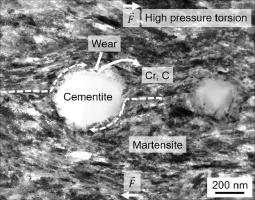当前位置:
X-MOL 学术
›
Acta Mater.
›
论文详情
Our official English website, www.x-mol.net, welcomes your
feedback! (Note: you will need to create a separate account there.)
Mechanism of cementite decomposition in 100Cr6 bearing steels during high pressure torsion
Acta Materialia ( IF 8.3 ) Pub Date : 2020-12-01 , DOI: 10.1016/j.actamat.2020.09.069 Yu Qin , David Mayweg , Po-Yen Tung , Reinhard Pippan , Michael Herbig
Acta Materialia ( IF 8.3 ) Pub Date : 2020-12-01 , DOI: 10.1016/j.actamat.2020.09.069 Yu Qin , David Mayweg , Po-Yen Tung , Reinhard Pippan , Michael Herbig

|
Abstract Severe plastic deformation leads to cementite decomposition in pearlitic and martensitic alloys, resulting in high-strength nanocrystalline ferrite. This effect can be employed to strengthen pearlitic wires but it can also be associated with material failure by white etching cracks (WECs) that are primarily known to concern bearings or rails. We investigate the decomposition of spheroidal cementite in the martensitic bearing steel 100Cr6 with 62 Rockwell hardness during high pressure torsion at 9.5 GPa applied pressure. The hard martensitic matrix and the even harder spheroidal cementite precipitates behave plastically very differently. The enforced macroscopic plastic deformation is almost entirely carried by the matrix. Plastic material flow of the matrix around the spheroidal cementite leads to wear of the spheroidal cementite as indicated by continuously increasing levels of chromium in the matrix. Plastic deformation of spheroidal cementite via dislocation gliding supposedly accelerates this process as slip steps generated thereby are preferential sites of wear at the matrix/cementite interface. Larger spheroidal cementite precipitates are more prone to plastic deformation and to decomposition than smaller ones. The mechanism likely holds true in general for multiphase materials with large strain difference between phases subjected to high pressure torsion. Although the formation of WECs in 100Cr6 bearings might be slowed down by reducing the size of the spheroidal cementite precipitates, it is unlikely that this could entirely prevent this failure mechanism.
中文翻译:

100Cr6轴承钢高压扭转渗碳体分解机理
摘要 珠光体和马氏体合金中剧烈的塑性变形导致渗碳体分解,形成高强度纳米晶铁素体。这种效应可用于强化珠光体线材,但它也可能与主要与轴承或导轨有关的白色蚀刻裂纹 (WEC) 导致的材料失效有关。我们研究了洛氏硬度为 62 的马氏体轴承钢 100Cr6 在施加 9.5 GPa 压力的高压扭转过程中球状渗碳体的分解。硬质马氏体基体和更硬的球状渗碳体沉淀物的塑性表现非常不同。强制宏观塑性变形几乎完全由基体承载。基体围绕球状渗碳体的塑性材料流动导致球状渗碳体的磨损,如基体中铬含量的不断增加所表明的。通过位错滑动引起的球状渗碳体塑性变形据说加速了这一过程,因为由此产生的滑移台阶是基体/渗碳体界面处的优先磨损位点。较大的球状渗碳体沉淀比较小的更容易发生塑性变形和分解。对于在承受高压扭转的相之间具有大应变差的多相材料,该机制可能普遍适用。尽管 100Cr6 轴承中 WEC 的形成可能会通过减小球状渗碳体析出物的尺寸而减慢,但这不太可能完全阻止这种失效机制。
更新日期:2020-12-01
中文翻译:

100Cr6轴承钢高压扭转渗碳体分解机理
摘要 珠光体和马氏体合金中剧烈的塑性变形导致渗碳体分解,形成高强度纳米晶铁素体。这种效应可用于强化珠光体线材,但它也可能与主要与轴承或导轨有关的白色蚀刻裂纹 (WEC) 导致的材料失效有关。我们研究了洛氏硬度为 62 的马氏体轴承钢 100Cr6 在施加 9.5 GPa 压力的高压扭转过程中球状渗碳体的分解。硬质马氏体基体和更硬的球状渗碳体沉淀物的塑性表现非常不同。强制宏观塑性变形几乎完全由基体承载。基体围绕球状渗碳体的塑性材料流动导致球状渗碳体的磨损,如基体中铬含量的不断增加所表明的。通过位错滑动引起的球状渗碳体塑性变形据说加速了这一过程,因为由此产生的滑移台阶是基体/渗碳体界面处的优先磨损位点。较大的球状渗碳体沉淀比较小的更容易发生塑性变形和分解。对于在承受高压扭转的相之间具有大应变差的多相材料,该机制可能普遍适用。尽管 100Cr6 轴承中 WEC 的形成可能会通过减小球状渗碳体析出物的尺寸而减慢,但这不太可能完全阻止这种失效机制。











































 京公网安备 11010802027423号
京公网安备 11010802027423号